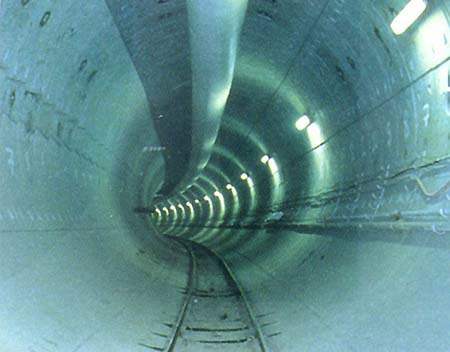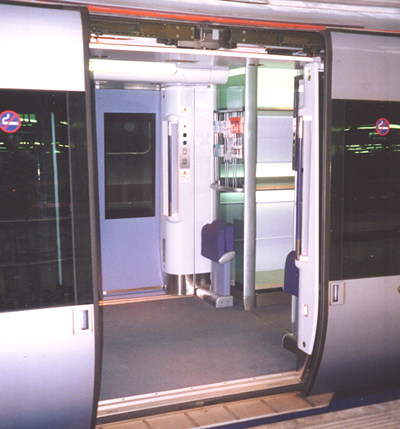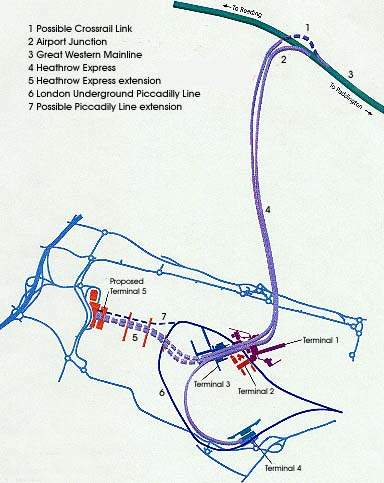The Heathrow Express is a high-speed service link offering the fastest journey time between Heathrow Airport and central London of 16 minutes and 21 minutes to Terminal 5. Its success since opening in 1998 has resulted in the strengthening of the train sets, and in June 2003 a further £30m service expansion was announced.
Growing air traffic at London’s Heathrow Airport saw the British Airports Authority (latterly BAA) undertake one of Europe’s largest construction projects, the new Terminal 5 that opened on 27 March 2008.
The original £350m project originated in 1993 as a joint venture between BAA and British Railways Board, designed to increase use of public transport to and from the airport from 34%, already the highest in the world, to 50%.
A train operating company, Heathrow Express Ltd, formed to plan, operate and introduce Heathrow Express, took over the running of the service after the project was completed. This company is a wholly-owned subsidiary of BAA, part of the Spanish Ferrovial Consortium since June 2006.
The project
BAA signed a 25-year agreement with Railtrack for the use of the 12 mile mainline stretch from Paddington to Airport Junction near Hayes. To help create the Heathrow Express service, overhead 25kV ac electrification was installed on the route, including Paddington platforms 3-12. BAA is responsible for the five mile underground section from Airport Junction to Terminal 4, via the central area.
Non-stop trains began running on 25 May 1998. The service is rare on British railways, in being separate from the franchising arrangements under which private companies pay the infrastructure owner, Network Rail, to operate trains over its tracks.
Heathrow Express services are operated by a fleet of purpose-built trains, capable of travelling at 100mph, leaving dedicated platforms at Paddington every 15 minutes between 5am and midnight.
Further new investment in 2003 provided for a new stopping service in conjunction with First Great Western that takes an extra 10 minutes between Paddington and Heathrow, calling at Ealing Broadway, West Ealing, Hanwell, Southall and Hayes.
Partly driven by the need for reliable transport for the large numbers of Heathrow workers living in west London (for whom special fares are available), the Connect service, unlike Heathrow Express, is part of National Rail. London Travelcards are valid as far as Hayes.
Infrastructure
For the first 12 miles, the route follows the Great Western Main line to Airport Junction, near Hayes where Heathrow trains diverge to enter a five-mile tunnel to the airport’s central area. There are three stations, one serving Terminals 1, 2 and 3, another for Terminal 4 located on the airport’s southern perimeter and the most recent for Terminal 5 at western end of the site.
Paddington station, the London terminus, has two platforms dedicated to Heathrow Express, and full airline passenger and luggage check-in facilities. Ticket machines are installed at Heathrow and Paddington to provide multi-lingual, credit card and through-ticket purchasing facilities.
Network Rail is responsible for trackwork, signalling and electrification of the line, also the signalling and telecommunications network in the tunnel section.
Heathrow Express gains access to Terminal 5 via a new spur connection. Mott McDonald won the contract to construct 800m of twin-bore tunnels plus 1.3km of twin tunnel to reach the new station complex for T5 located in the basement of Concourse A.
Shafts and cross-tunnels provide for ventilation and emergency evacuation. The boring had to be carefully managed, as it passed underneath the existing London Underground Piccadilly Line in two places.
The new station is designed as a major public transport interchange. The equivalent size of six football pitches, it has four active platforms – two for the Piccadilly Line and two for the Heathrow Express. A further pair are safeguarded for future use, possibly under the AirTrack scheme to link to the south west with main lines via Staines.
The station is designed to make use of natural light via a glazed atrium. An internal driverless ‘track transit system’ is being installed at the T5 site for transporting passengers from the main building to two satellites. The T5 extension and station opened on 27 March 2008 along with the terminal, although without the hitches and adverse publicity that blighted the building’s launch.
Rolling stock
Heathrow Express owns 14 four-car Class 332 trains engineered and built by Siemens Transportation Systems in Germany, in partnership with CAF of Spain. The order was to prove a forerunner to Siemens’ great success in the UK rail market in the following years.
Each carriage features considerable space for baggage, and all seats face the nearest baggage area. On-board telephones are installed. Extra cars have been delivered to extend some Class 332s to five cars, a reflection of how the service has taken off since 1998. Disabled access to the carriages is eased by each carriage floor being level with each platform. There is one toilet (including disabled facilities) to every three carriages.
Trains tend to operate in nine-car formations (a five-coach train and a four-car train coupled together).
The stopping service, Heathrow Connect, is operated by five Siemens Desiro Class 360/2 EMUs, built in Germany and Austria during 2004, and similar to the Class 360s on the London Liverpool Street-Colchester route. With the revisions to the airport’s operation, Heathrow Connect now provides the service to Terminal 4 and does not directly serve Terminal 5.
The basic Heathrow Express service between Paddington and Terminal 5 is four per hour. The half-hourly Heathrow Connect allows for transfer on the Express service at the Terminals 1–3 station.
Siemens has a 19-year contract to provide a 24 hours a day, 365 days per year maintenance service for the Heathrow Express/Connect fleets at the purpose-built facility at Old Oak Common, north of the Great Western main line.
Signalling and communications
Trains are ATP-equipped and run under the same signalling system as other services using the Great Western main line. Each passenger car is equipped with four television screens providing check-in and airline information.
Despite the short 15 minute journey time between Paddington and Heathrow, Wi-Fi internet access is being provided on all Heathrow Express trains as a reflection of its position in the business market. Heathrow Connect trains feature in-carriage indicators and announcements. The jointly used Terminal 5 station is operated by Heathrow Express staff, as opposed to the separate station areas for Underground and Heathrow Express at the other terminals.
The future
Other schemes involving the Heathrow Express route have also been mooted, notably for tunnel extensions to allow through services by long distance trains. However, the government’s support for the Crossrail scheme provides for direct access to the Heathrow line underneath central London from the East, subject to agreement with BAA.
It is not clear whether this will result in the abandonment of the long-discussed St Pancras-Heathrow Express direct service, running four times an hour and keying in with the central London interchange of main line services, Underground, Thameslink and HS1 (Channel Tunnel Rail Link).









